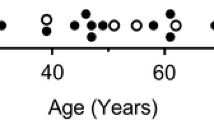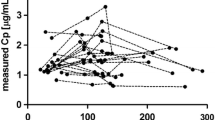Summary
The pharmacokinetics and pharmacodynamics of pancuronium were studied following intravenous infusion in eleven patients undergoing surgical anaesthesia. Measurement of the plasma concentrations (Cp) of the neuromuscular blocking agent (NMBA) and the concomitant intensities of paralysis allowed their simultaneous modelling. The pharmacokinetic parameters derived for pancuronium were in the range of previously reported values, except that the mean total systemic plasma clearance (0.79±0.28 ml·min−1·kg−1) was reduced and the mean terminal phase half-life (169 min) was longer in these patients. Plasma concentration and % paralysis data were successfully fitted to a previously proposed pharmacodynamic model. This model assumes a separate effect compartment which exchanges drug directly with the central kinetic compartment (integrated effect model). The ‘steady-state’ Cp necessary to produce 50% paralysis (ECpss(50)) was estimated to be 0.21±0.08 µg·ml−1 (mechanical response) and 0.18±0.05 µg·ml−1 (EMG response). An analysis using the Hill equation of the Cp-response relationship, during and after the constantrate infusion of pancuronium bromide, resulted in effective plasma concentrations for 50% paralysis (ECp50) of 0.35±0.06 µg·ml−1 and 0.20±0.09 µg·ml−1, respectively, for mechanical twitch response. The corresponding values for EMG response were 0.32±0.06 µg·ml−1 and 0.17±0.06 µg·ml−1. Using this latter approach, the ECp50 estimated during onset of paralysis was significantly higher than that estimated during offset of paralysis (p<0.05); no such difference was apparent between this latter parameter and the ECpss(50) of the integrated effect model (p>0.05). No significant differences were observed between any of the pharmacodynamic parameter estimates generated from the data obtained from the two methods of assessment of neuromuscular function (mechanical vs. EMG response) (p>0.05).
Similar content being viewed by others
References
Boxenbaum HG, Riegelman S, Elashoff RM (1974) Statistical estimations in pharmacokinetics. J Pharmacokinet Biopharm 2: 123–148
Boxenbaum HG, Geitner KA, Jack ML, Dixon WR, Kaplan SA (1977) Pharmacokinetic and biopharmaceutic profile of chlordiazepoxide HCl in healthy subjects. Multiple dose oral administration. J Pharmacokinet Biopharm 5: 25–39
Colburn WA (1981) Simultaneous pharmacokinetic and pharmacodynamic modelling. J Pharmacokinet Biopharm 9: 367–388
Cronnelly R, Fisher DM, Miller RD, Gencarelli P, Nguyen-Gruenke L, Castagnoli N (1983) Pharmacokinetics and pharmacodynamics of vecuronium (ORG NC45) and pancuronium in anesthetized humans. Anesthesiology 58: 405–408
D'Hollander A, Delcroix C (1981) An analytical pharmacodynamic model for nondepolarising neuromuscular blocking agents. J Pharmacokinet Biopharm 9: 27–40
Duvaldestin P, Demetriou M, d'Hollander A (1982a) Pharmacokinetics of pancuronium in man: a linear system. Eur J Clin Pharmacol 23: 369–372
Duvaldestin P, Saada J, Berger JL, d'Hollander A, Desmonts JM (1982b) Pharmacokinetics, pharmacodynamics, and dose-response relationships of pancuronium in control and elderly subjects. Anesthesiology 56: 36–40
Epstein RA, Epstein RM (1973) The electromyogram and the mechanical response of indirectly stimulated muscle in anesthetized man following curarization. Anesthesiology 38: 212–223
Gibaldi M, Perrier D (1982) Pharmacokinetics (2nd edn). Marcel Dekker Inc, New York
Ham J, Stanski DR, Newfield P, Miller RD (1981) Pharmacokinetics and dynamics of d-tubocurarine during hypothermia in humans. Anesthesiology 55: 631–635
Hull CJ, Van Beem HBH, McLeod K, Sibbald A, Watson MJ (1978) A pharmacodynamic model for pancuronium. Br J Anaesth 50: 1113–1123
Katz RL (1973) Electromyographic and mechanical effects of suxamethonium and tubocurarine on twitch, tetanic and posttetanic responses. Br J Anaesth 45: 849–859
McLeod K, Hull CJ, Watson MJ (1979) Effects of ageing on the pharmacokinetics of pancuronium. Br J Anaesth 57: 435–438
Miller RD, Agoston S, Booij LHDJ, Kersten UW, Crul JF, Ham J (1978) The comparative potency and pharmacokinetics of pancuronium and its metabolites in anesthetized man. J Pharmacol Exp Ther 207: 539–543
Miller RD, Way WL, Dolan WM, Stevens WC, Eger II EI (1972) The dependence of pancuronium- and d-tubocurarine-induced neuromuscular blockades on alveolar concentrations of halothane and forane. Anesthesiology 37: 537–581
Nogami H, Hanano M, Awazu S, Moon HH (1969) Pharmacokinetic analysis on the disappearance of ethoxybenzamide from plasma: statistical treatment of data of two compartment model by a digital computer. Chem Pharm Bull 17: 2097–2104
Pedersen PV (1977) Curve fitting and modelling in pharmacokinetics and some practical experiences with NONLIN and a new program FUNFIT. J Pharmacokinet Biopharm 5: 513–531
Ramzan MI, Shanks CA, Triggs EJ (1983) Relationship between gallamine plasma concentration and neuromuscular paralysis in surgical patients. J Clin Pharmacol 23: 243–251
Shanks CA, Ramzan MI, Triggs EJ (1979a) Studies in man with a constant-rate infusion of tubocurarine. Anaesth Intens Care 7: 209–214
Shanks CA, Somogyi AA, Ramzan MI, Triggs EJ (1980) Tubocurarine and pancuronium: a pharmacokinetic view. Anaesth Intensive Care 8: 4–12
Shanks CA, Somogyi AA, Triggs EJ (1979b) Dose-response and plasma concentration-response relationships of pancuronium in man. Anesthesiology 51: 111–118
Sheiner LB, Stanski DR, Vozeh S, Miller RD, Ham J (1979) Simultaneous modelling of pharmacokinetics and pharmacodynamics: application to d-tubocurarine. Clin Pharmacol Ther 25: 358–371
Somogyi AA, Shanks CA, Triggs EJ (1978) Combined intravenous bolus and infusion of pancuronium bromide. Br J Anaesth 50: 575–582
Stanski DR, Ham J, Miller RD, Sheiner LB (1979a) Pharmacokinetics and pharmacodynamics of d-tubocurarine during nitrous oxide-narcotic and halothane anesthesia in man. Anesthesiology 51: 235–241
Stanski DR, Sheiner LB (1979b) Pharmacokinetics and dynamics of muscle relaxants. Anesthesiology 51: 103–105
Wagner JG (1968) Kinetics of pharmacologic response. I. Proposed relationship between response and drug concentration in the intact animal and man. J. Theor Biol 20: 173–201
Walker JS, Shanks CA, Brown KF (1983) Alcuronium kinetics and plasma concentration-effect relationship. Clin Pharmacol Ther 33: 510–516
Wingard LB, Abouleish E, West DC, Goehl TJ (1979) Modified fluorimetric quantitation of pancuronium bromide and metabolites in human maternal and umbilical serums. J Pharm Sci 68: 914–916
Whiting B, Kelman AW (1980) The modelling of drug response. Clin Sci 59: 311–315
Author information
Authors and Affiliations
Rights and permissions
About this article
Cite this article
Evans, M.A., Shanks, C.A., Brown, K.F. et al. Pharmacokinetic and pharmacodynamic modelling with pancuronium. Eur J Clin Pharmacol 26, 243–250 (1984). https://doi.org/10.1007/BF00630293
Received:
Revised:
Accepted:
Issue Date:
DOI: https://doi.org/10.1007/BF00630293




